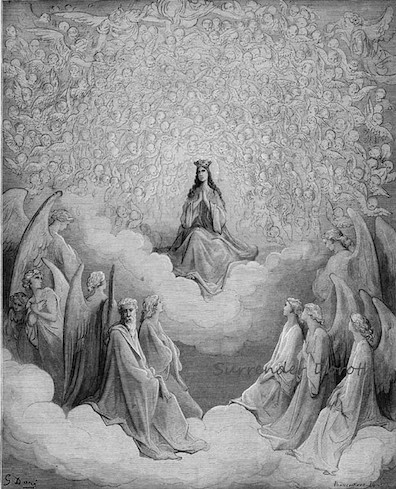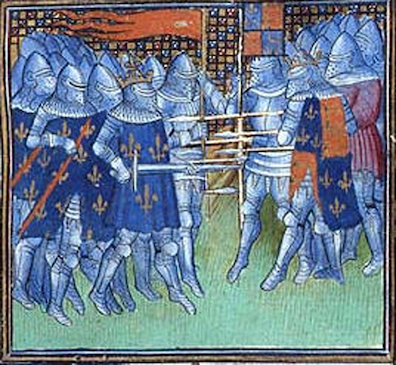His rhymes seem like a pair of men: "Mouth, south. Is the
mouth south someway? Or the south a mouth? Must be some.
South, pout, out, shout, drouth. Rhymes: two men dressed
the same, looking the same, two by two." Gifford
plausibly suggests that, "In view of the freewheeling
associations from Dante that follow," they recall two men seen
at the end of the revelatory procession in Purgatorio
29: "I made out two old men, unlike in their attire / but
alike in bearing, honorable and grave" (134-35). These
men, St. Luke and St. Paul, are not "dressed the same," but
they do look alike, and since Stephen soon thinks of three
ladies who come just before them in the pageant (lines
121-29), it is reasonable to suppose that he has them in mind.
This impression is strengthened several sentences later when,
after recalling various women in Dante's poem, Stephen again
thinks of his rhymes as men, who are now "old": "But I old
men, penitent, leadenfooted, underdarkneath the night:
mouth south: tomb womb."
Dante's rhymes do in a sense go "two by two," in that
his poem is composed of tercets bookended by pairs of rhymes
(ABA), but each pair brackets a new sound that will form the
next rhyming pair (ABA, BCB, CDC), so it is truer to say that
the terza rima verse goes "three by three."
Stephen introduces this shift from twoness to threeness, and
also from maleness to femaleness, by recalling three linked
rhymes from Inferno 5:
. . . . . . . . . . . . . . .
. la tua pace
. . . . . . . . . . . .
. che parlar ti piace
. . . . mentreche il
vento, come fa, si tace. (92, 94, 96)
The speaker is Francesca da Rimini, the charming adulterer with
whom Dante converses in the circle of lust. She says, "if the
King of the universe were our friend / we would pray that He
might give you peace (
la tua pace), / since you show pity
for our grievous plight. / We long to hear and speak (
parlar)
of that / which you desire (
vi piace) to speak and know,
/ here, while the wind has calmed (
ci tace)." (Stephen's
memory of the lines is not perfect.)
Having recalled this woman's three rhymes, Stephen now
visualizes
them as the three women of
Purgatorio 29: "
He saw
them three by three, approaching girls, in green, in rose, in
russet, entwining." In Dante's parade three women pass by
in bright shades of emerald green, fire red, and snow white (not
green, pink, and reddish brown), representing the "theological"
virtues of hope, love, and faith. Gifford suggests that
Stephen's quasi-synesthetic notion that they are rhymes was
inspired by a fancy attributed to Dante himself, one of whose
earliest commentators, Benvenuto da Imola, reported the "quaint
conceit" of another admirer: "When Dante first set about the
composition of his poem, all the rhymes in the language
presented themselves in the guise of lovely maidens, each
petitioning 'to be granted admission' into
The Divine Comedy.
In answer to their prayers, Dante called first one and then
another, and assigned to each its appropriate place in the poem,
so that, when at last the work was complete, it was found that
not a single one had been left out."
Stephen now briefly returns once more to
Inferno 5 with
the thought that the three girls move "
per l'aer perso, in
mauve, in purple." Francesca uses this Italian phrase when
she first responds to Dante's call. She addresses him as a kind
stranger who comes "through somber air (
per l'aere perso)
to visit us" (88-90). The word
perso means lost, wasted,
ruined––a sense which suits the gloom of Hell––but it can also
mean dark or deep purple. Slote quotes an apposite sentence from
Dante's
Convivio: "Perse is a color composed of purple
and black, but black predominates." Why, one may ask, does
Stephen apply this somberly colorful adjective from the
Inferno
to the three girls of
Purgatorio, thinking of them
as dressed "in
mauve,
in purple"? The reason can be found in a single tercet between
the descriptions of the three ladies and the two old men: "Four
other ladies, dressed in purple (
in porpore vestite), /
were dancing at the left" (130-31), their color emblematic of
the four "cardinal" virtues of Roman antiquity.
The purple women give way in Stephen's thoughts to a golden one:
"
quella pacifica oriafiamma, in gold of
oriflamme, di rimirar fè più ardenti." Here
he recalls the moment in
Paradiso 31 when St. Bernard
directs the pilgrim's gaze upward to Mary, the queen of Heaven,
who looks like the glow of the sun about to rise in the east.
When Dante calls her "that peaceful oriflamme (
quella
pacifica oriafiamma)" in line 127, he is referring
oxymoronically
to the battle standard of French kings, which displayed an
aurea
fiamma (Latin for golden flame) on a darker background.
Once again it seems that Stephen may be making an uncannily
perceptive connection between the colors in widely separated
parts of Dante's poem, because early oriflamme banners were
predominantly purple. Slote quotes from J. W. Mollet's
Illustrated
Dictionary of Antique Art and Archaeology (1987): "The
ancient royal banner of France, coloured purple-azure and gold.
It was split into five points, and sometimes bore upon it a
saltire wavy, from the centre of which golden rays diverged."
Slote observes that "Later oriflamme flags were fiery red."
Stephen now jumps ahead 15 lines to the end of the canto when,
having joined Bernard in looking at Mary, Dante sees that his
guide's eyes are so loving "that he made mine more ardent in
their gaze (
che' miei di rimirar fé più ardenti)." Here
all consideration of rhymes seems to get left aside in the
interest of reflecting on Dante's ecstatic tone. But the
goldenness of Mary lingers, and she seems to have been included
as one more instance of female principles whose colors signify
rhyming harmony.
Stephen concludes his long reverie by contrasting the
colorful female splendors of the Commedia with his own
poor attempt at poetry: "But I old men, penitent,
leadenfooted, underdarkneath the night: mouth south:
tomb womb." Lead is the dull metallic antithesis of brilliant
gold, so this sentence must be read as a despairing confession
of poetic incompetence. The final pages of Aeolus show
Stephen trying his hand at a different kind of literary art,
prose fiction. But his off-the-cuff, from-memory reflections
on the Commedia evidence rich poetic sensibility.
Starting with a fanciful conceit supposedly entertained by
Dante himself––that rhymes are like beautiful women––he blends
it with color references from all three parts of the great
epic poem to find reasons in rhymes.




